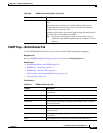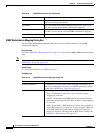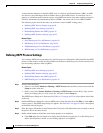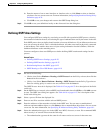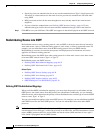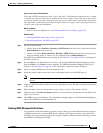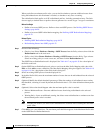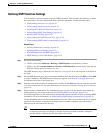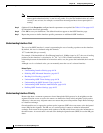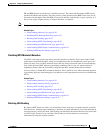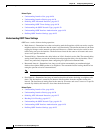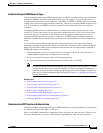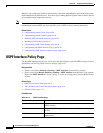
64-25
User Guide for Cisco Security Manager 4.4
OL-28826-01
Chapter 64 Configuring Routing Policies
OSPF Routing on Cisco IOS Routers
Defining OSPF Interface Settings
You can modify a variety of interface-specific OSPF parameters. This procedure describes how to define
these parameters. For more information about a particular parameter, see the following topics:
• Understanding Interface Cost, page 64-26
• Understanding Interface Priority, page 64-26
• Disabling MTU Mismatch Detection, page 64-27
• Understanding OSPF Timer Settings, page 64-28
• Blocking LSA Flooding, page 64-27
• Understanding the OSPF Network Type, page 64-29
• Understanding OSPF Interface Authentication, page 64-29
Related Topics
• Defining OSPF Process Settings, page 64-20
• Defining OSPF Area Settings, page 64-21
• Redistributing Routes into OSPF, page 64-22
• OSPF Routing on Cisco IOS Routers, page 64-19
Step 1 Do one of the following:
• (Device view) Select Platform > Routing > OSPF Interface from the Policy selector.
• (Policy view) Select Router Platform > Routing > OSPF Interface from the Policy Type selector.
Select an existing policy or create a new one.
The OSPF Interface page is displayed. See Table 64-11 on page 64-30 for a description of the fields on
this page.
Step 2 On the OSPF Interface page, select an interface definition from the table, then click Edit, or click Add
to create a definition. The OSPF Interface dialog box appears. See Table 64-12 on page 64-32 for a
description of the fields in this dialog box.
Step 3 Enter the name of the interface or interface role to define, or click Select to select an interface role from
a list or to create a new one. For more information, see Specifying Interfaces During Policy Definition,
page 6-70.
Step 4 Define interface authentication. The authentication type you select for the interface must match the
authentication type you select for the area (see Defining OSPF Area Settings, page 64-21).
All neighboring routers on the same network must have the same password to be able to exchange OSPF
information. For more information, see Understanding OSPF Interface Authentication, page 64-29.
The key ID number can be associated with multiple passwords. This is an easy and secure way to migrate
passwords. For example, to migrate from one password to another, configure a password under a
different key ID, then remove the first key.
Tip The key ID number can be associated with multiple passwords. This is an easy and secure way
to migrate passwords. For example, to migrate from one password to another, configure a
password under a different key ID, then remove the first key.



